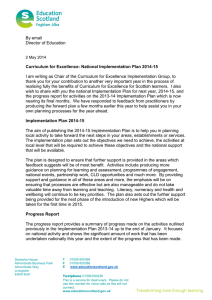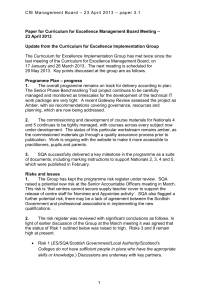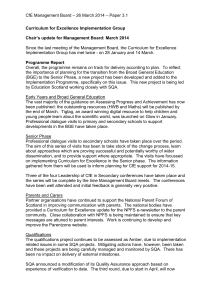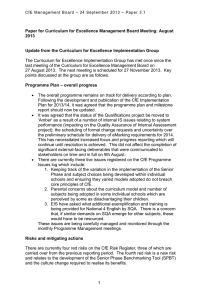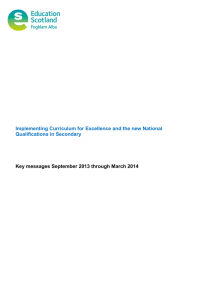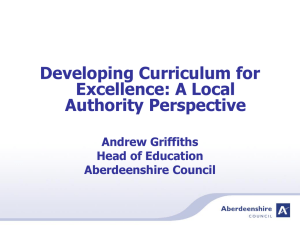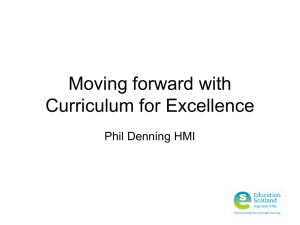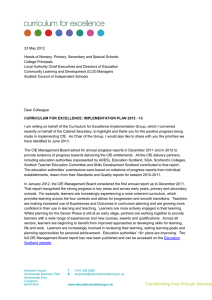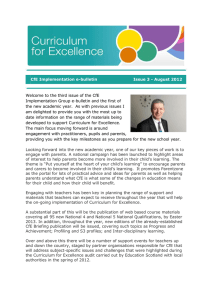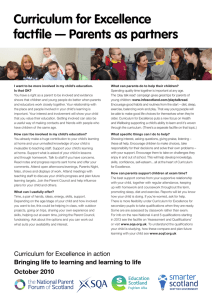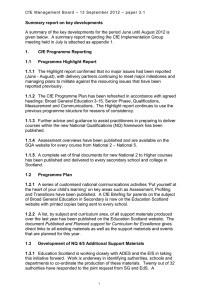The new experiences and outcomes
advertisement
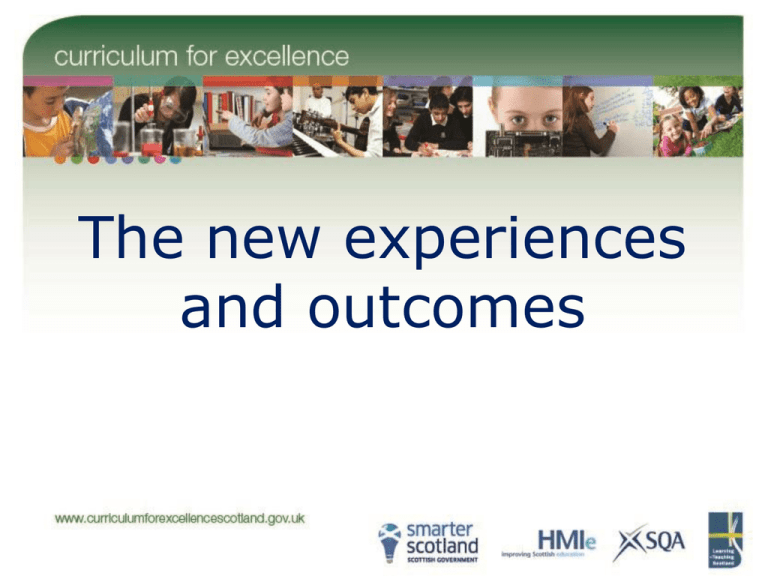
The new experiences and outcomes The new experiences and outcomes: outline of presentation Why is CfE even more important now? Experiences and outcomes:when, how, what? Where do they fit within the curriculum as a whole? How can we turn all this into reality? [Insert photograph of child here to emphasise that we are always relating our worth on the curriculum to the needs of the children we serve] Why is CfE even more important now? To enable each child and young person to flourish Economy and society: an uncertain future Developments in our education system and findings about its performance See ‘The case for change’ on the Curriculum for Excellence website Why is CfE even more important now? Improving Scottish Education 2009 ‘Scotland’s future economic prosperity requires an education system within which the population as a whole will develop the kind of knowledge, skills and attributes which will equip them personally, socially and economically to thrive in the 21st century. ‘It also demands standards of attainment and achievement which match these needs and strengthen Scotland’s position internationally.’ HM Senior Chief Inspector, Improving Scottish Education 2009 • substantial strengths in Scottish education, including professionalism of workforce and capacity for improvement • issues to be addressed in order for our high aspirations to be achieved for education and for learners – see Chapter 5, for example. How were the experiences and outcomes developed? • unparalleled engagement with teachers and practitioners • building upon the existing very good practice across all sectors • taking account of research and international comparisons • recognising the professionalism of teachers – needed so that they can exercise professional freedom and responsibility as they plan with the broader guidance. See ‘Process of change’ on the Curriculum for Excellence website Engagement and trialling was used to shape the experiences and outcomes: 1475 questionnaires 937 from groups 500 trialling centres 241 reports Total 2012 submissions 20 Focus groups e.g. Royal Society of Edinburgh University of Glasgow analysis and reports Plans drawn up to address issues raised Further engagement and consultation, comparisons, refinement; thematic overview Publication What did people say? What happened in response? • They emphasised the need for time and professional dialogue to deepen and share understanding • They were positive about how the Es and Os would give scope for – – – – flexibility and creativity developing the four capacities teaching in motivating ways making connections in learning • They had concerns about – ‘vagueness’ – fit with assessment – Curriculum area-specific points • Editing/revision (varied amounts) • Explanation (selective – as appendices to Es and Os) • Exemplification (selective – to be developed over time) – Illustration of expectations where necessary – Movies of E/Os in action – Pupil work – Case studies – Links to resources i.e. providing ‘scaffolding’, not detail Experiences and outcomes: what do we need to know? • They describe all of the curriculum from age 3 to 15 and in particular a ‘broad general education’ • They replace but build on previous guidance (3 to 5 and 5-14) • Taken together, they embody the four capacities • ‘Experience’ and ‘outcome’ See ‘Getting started’ on the Curriculum for Excellence website Experiences and outcomes: example Principles and practice sections (a ‘must read’ for everyone) See ‘Process of change’ on the Curriculum for Excellence website Experiences and outcomes: example See ‘Process of change’ on the Curriculum for Excellence website Where do the experiences and outcomes fit within the curriculum as a whole? Building the Curriculum 3: A framework for learning and teaching The purpose of the curriculum The curriculum: Learning and teaching Values Wisdom, justice, Compassion, integrity all that we plan for Building theand curriculum children young people’s learning Engaging, active, challenging Building up The curriculum Experiences and outcomes Entitlements For all children and young people Expectations for learning and development from early to fourth levels Arrangements for Personal support Including preparing for and support through changes and choices Principles of curriculum design Assessment Qualifications Self-evaluation and accountability, Professional development Support purposes of learning Entitlements: • A coherent curriculum from 3 to 18 • A broad general education from age 3 to the end of S3 • A senior phase: opportunities for qualifications and other planned opportunities to develop the four capacities • Opportunities to develop skills for learning, skills for life and skills for work • Opportunities to achieve to the highest levels through personal support and challenge • Opportunities and support to move into positive and sustained destinations beyond school A broad general education 3 to 15 • Every child and young person in Scotland is entitled to experience a broad general education. • This broad general education takes place from the early years to the end of S3. • It is represented by learning across all** of the experiences and outcomes to the third curriculum level together with those selected for study at the fourth, as far as is consistent with each child or young person’s needs. • ‘Not expected that qualifications will feature at this stage’ • Providing a strong platform for later learning and qualifications True or false? 1. CfE = interdisciplinary or thematic learning 2. Broad general education = common course 3. Es and Os to third level = a menu to choose from 4. Number of qualifications in S4 = 5 5. Active learning = energetic learning Please help to counter these misconceptions! Bringing Curriculum for Excellence to life throughout Scotland: Local implementation plans with tasks, roles and timescales ‘Testing the framework’ - thinking from schools The process of change – 8 themes emerging 1. Securing a strong ethos and values is often the starting point 2. Giving high priority to achieving a consistently high quality of learning and teaching across the school 3. Importance of staff learning together, for example seeing each other teach, reflecting together on the experiences and outcomes within their own area of interest and across them all 4. Using literacy, numeracy and health and wellbeing as starting points 5. Importance of knowing about the progress of every child across a wider range than before – roles of all staff in this endeavour 6. Coherence and progression need more joint thinking and partnership than before. This requires strategic support at senior levels 7. Need to work across a range of developments in a well-sequenced, planned way 8. Leadership essential, in all its facets – using all resources to the full, coaching, planning, setting high expectations How will we turn this into reality? Not research, development, dissemination as in previous developments But creating together through learning and thinking together Photocredit: EwanMcintosh Some possible questions: • • • • • • For schools and their partners: How will we ensure that all young people achieve the third curriculum level across all curriculum areas? How will we provide specialisation, choice, depth and challenge within the fourth level for all young people? For any particular development or action: how does it contribute to the broad general education? What will be its impact on learning? What is the ‘educational gain’? For teachers How rich is the experience and how deep the learning within this level? How can I contribute to these children’s broad general education (including literacy, numeracy, health and wellbeing)? For any development or activity: how does it contribute to the broad general education? How will I know? [Return to photograph of child or children]
